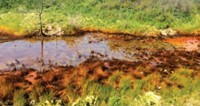Advertisement
Grab your lab coat. Let's get started
Welcome!
Welcome!
Create an account below to get 6 C&EN articles per month, receive newsletters and more - all free.
It seems this is your first time logging in online. Please enter the following information to continue.
As an ACS member you automatically get access to this site. All we need is few more details to create your reading experience.
Not you? Sign in with a different account.
Not you? Sign in with a different account.
ERROR 1
ERROR 1
ERROR 2
ERROR 2
ERROR 2
ERROR 2
ERROR 2
Password and Confirm password must match.
If you have an ACS member number, please enter it here so we can link this account to your membership. (optional)
ERROR 2
ACS values your privacy. By submitting your information, you are gaining access to C&EN and subscribing to our weekly newsletter. We use the information you provide to make your reading experience better, and we will never sell your data to third party members.
Environment
Study Warns Of Fracking Water Contaminants
by Jeff Johnson
October 7, 2013
| A version of this story appeared in
Volume 91, Issue 40
Duke University researchers have found elevated levels of radioactivity, salts, and metals in water and sediments in a western Pennsylvania creek where treated water from oil and gas operations is discharged. The discharge is from a brine treatment facility that processes shale natural gas wastewater from hydraulic fracturing operations (Environ. Sci. Technol. 2013, DOI: 10.1021/es402165b). The researchers found radium levels in sediments downstream of the treatment facility to be about 200 times as high as those in sediments upstream of the plant. The report noted that radiation levels in the water discharge were within legal industrial limits. However, the researchers said radium levels concentrated in sediments near the plant’s outfall would be acceptable only at a licensed radioactive disposal facility. Earlier research found that fracking wastewater in the Marcellus Shale region, where the creek is located, is usually high in salinity and radioactivity. Gas industry officials note that Pennsylvania public water treatment plants voluntarily stopped receiving wastewater from fracking operations in 2011, but private companies in the area still accept such wastewater.





Join the conversation
Contact the reporter
Submit a Letter to the Editor for publication
Engage with us on Twitter